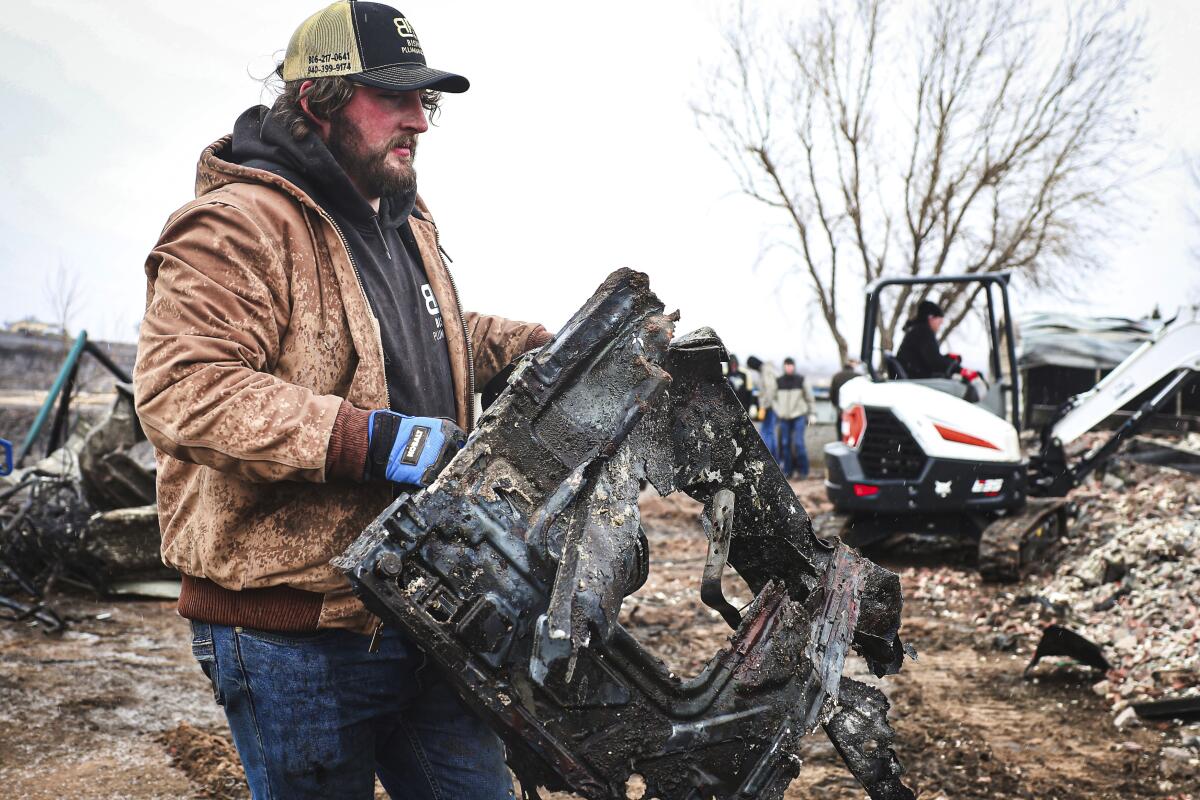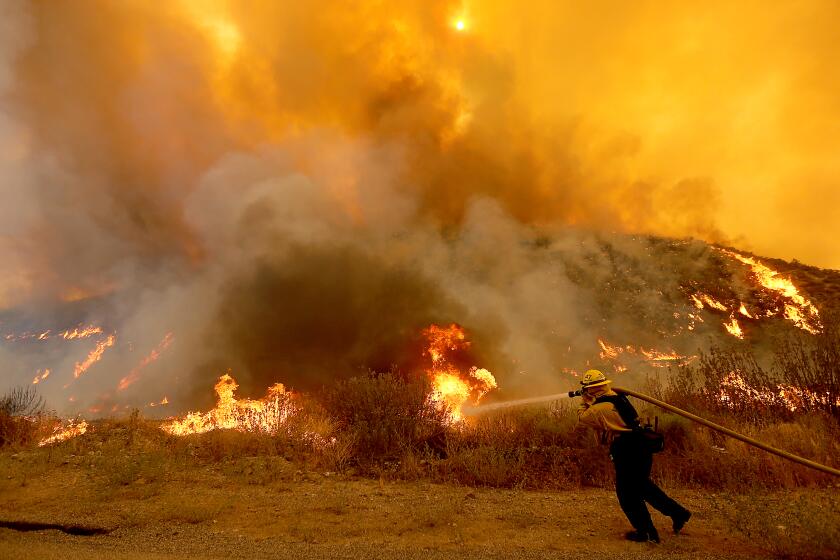A Texas town was helpless to watch as the largest wildfire in state history engulfed it

- Share via
STINNETT, Texas — As the largest wildfire in Texas history engulfed his town, Danny Phillips was left helpless.
“We had to watch from a few miles away as our neighborhood burned,” he said, his voice trembling.
In his hard-hit town of Stinnett, population roughly 1,600, families like his who evacuated from the Smokehouse Creek fire returned to devastating scenes: melted street signs and charred frames of cars and trucks. Homes reduced to piles of ash and rubble. An American flag propped up outside a destroyed house.
Phillips’ one-story home was still standing, but several of his neighbors weren’t so fortunate.
Stinnett’s destruction was a reminder that, even as snow fell Thursday and helped firefighters, crews are racing to stamp out the blaze ahead of higher temperatures and winds forecast in the coming days.
Already, the Smokehouse Creek fire has killed two people and left behind a desolate landscape of scorched prairie, dead cattle and burned-out homes in the Texas Panhandle.
The blaze stayed about the same size Friday, just shy of 1,700 square miles. It merged with another fire and is 5% contained, up from 3% on Thursday. according to the Texas A&M Forest Service. The largest of several major fires burning in the rural Panhandle section of the state, it has also crossed into Oklahoma.
But conditions favorable for wildfires are expected to extend through the weekend in parts of Texas, Oklahoma, Kansas and New Mexico, according to the National Weather Service. Strong winds, relatively low humidity and dry conditions are creating conditions that the weather service said are “resulting in a significant threat for the rapid spread of wildfires.”
Between 1996 and 2020, wildfire burn areas in California grew five times larger than in the 25 years prior. Scientists say climate change is to blame.
Crews will focus on the northern edge of the Smokehouse Creek fire and areas around structures, the forest service said.
Gray skies loomed over huge scars of blackened earth in a rural area dotted with scrub brush, ranchland, rocky canyons and oil rigs. Firefighter Lee Jones was helping douse the smoldering wreckage of homes in Stinnett to keep them from reigniting when the weather starts turning.
“The snow helps,” said Jones, who was among a dozen firefighters called in from Lubbock to help. “We’re just hitting all the hot spots around town, the houses that have already burned.”
Authorities have not said what ignited the fires, but strong winds, dry grass and unseasonably warm weather fed them.
“The rain and the snow is beneficial right now — we’re using it to our advantage,” Texas A&M Forest Service spokesperson Juan Rodriguez said of the Smokehouse Creek fire. “When the fire isn’t blowing up and moving very fast, firefighters are able to actually catch up and get to those parts of the fire.”
Previously, the largest fire in recorded state history was the 2006 East Amarillo Complex fire, which burned about 1,400 square miles and left 13 people dead.
Two women have been confirmed killed by the fires this week. But with flames still menacing a wide area, authorities haven’t yet thoroughly searched for victims or tallied homes and other structures damaged or destroyed.
Cindy Owen was driving in Texas’ Hemphill County south of Canadian on Tuesday afternoon when she encountered fire or smoke, said Sgt. Chris Ray of the state’s Department of Public Safety. She got out of her truck, and flames overtook her.
A passerby found Owen and called first responders, who took her to a burn unit in Oklahoma. She died Thursday morning, Ray said.
The other victim, an 83-year-old woman, was identified by family members as Joyce Blankenship, a former substitute teacher. Her grandson, Lee Quesada, said deputies told his uncle Wednesday that they had found Blankenship’s remains in her burned home.
President Biden, who was in Texas on Thursday to visit the U.S.-Mexico border, said he directed federal officials to do “everything possible” to assist fire-affected communities, including sending firefighters and equipment. The Federal Emergency Management Agency has guaranteed Texas and Oklahoma will be reimbursed for their emergency costs, the president said.
“When disasters strike, there’s no red states or blue states where I come from,” Biden said. “Just communities and families looking for help. So we’re standing with everyone affected by these wildfires and we’re going to continue to help you respond and recover.”
Republican Texas Gov. Greg Abbott issued a disaster declaration for 60 counties and planned to visit the Panhandle on Friday.
The weekend forecast and “sheer size and scope” of the blaze are the biggest challenges for firefighters, said Nim Kidd, chief of the Texas Division of Emergency Management.
“I don’t want the community there to feel a false sense of security that all these fires will not grow anymore,” Kidd said. “This is still a very dynamic situation.”
Jeremiah Kaslon, a Stinnett resident who saw neighbors’ homes destroyed by flames that stopped just on the edge of his property, seemed prepared for what the changing forecast might bring.
“Around here, the weather, we get all four seasons in a week,” Kaslon said. “It can be hot, hot and windy, and it will be snowing the next day. It’s just that time of year.”
Encroaching flames caused the main facility that disassembles America’s nuclear arsenal to pause operations Tuesday night, but it was open for normal work by Wednesday. The small town of Fritch, which lost hundreds of homes in a 2014 fire, saw 40 to 50 more destroyed this week, Mayor Tom Ray said.
Texas Agriculture Commissioner Sid Miller estimated cattle deaths to be in the thousands, with more likely to come.
“There’ll be cattle that we’ll have to euthanize,” Miller said. “They’ll have burned hooves, burned udders.”
Miller said individual ranchers could suffer devastating losses. But he predicted the overall impact on the Texas cattle industry and on consumer prices for beef would be minimal.
Murphy reported from Stinnett, Vertuno from Austin. AP journalists Ty O’Neil in Stinnett, Texas, Jamie Stengle in Dallas, and Ken Miller in Oklahoma City contributed to this report.
More to Read
Sign up for Essential California
The most important California stories and recommendations in your inbox every morning.
You may occasionally receive promotional content from the Los Angeles Times.












